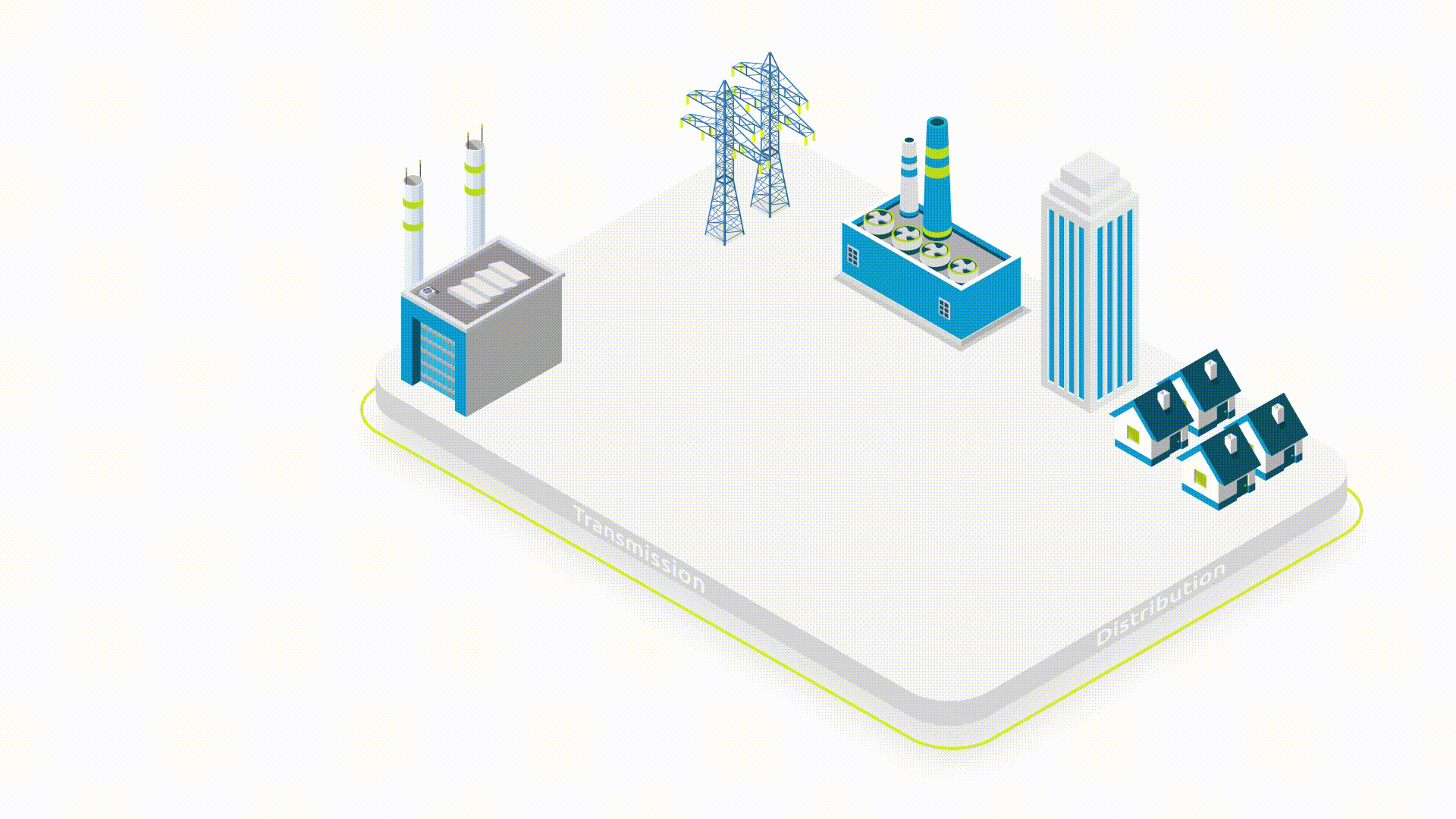18 Mar 2024
In today’s fast changing technological landscape, one problem that many utilities firms are facing is the shift from traditional hardwired infrastructure to digital substations. Power substation digitization is not just a useful industry insight; it’s an important subject for mission-critical businesses looking to improve reliability and optimize operations.
In this article, we’ll explore the world of digital substations, breaking down what they are and why they matter.
What is Digital Substation?
A digital substation is a modernized and technologically advanced version of a traditional electrical substation.
Digital substations use modern sensors, communication networks, digital technology, and intelligent devices to monitor, control, and manage electrical assets, in contrast to traditional substations that depend on analog systems and manual operations.
At its core, a digital substation uses digital technologies to provide remote control, predictive maintenance, and real-time monitoring of critical power distribution equipment.

Core Aspects of Digital Substations
- Intelligent devices: Digital substations are equipped with intelligent devices (IEDs), such as digital relays, programmable logic controllers (PLCs), and smart meters, that enable automated control and monitoring of electrical equipment. By supporting advanced functionalities like load balancing, adaptive protection schemes, and fault detection, isolation, and restoration (FDIR), these devices increase the reliability and effectiveness of power distribution systems.
- Advanced sensors: offer data in real time on variables like power quality, voltage, current, and temperature. Proactive monitoring and predictive maintenance of electrical assets are made possible by these sensors.
- Ethernet-based communication networks: standards like IEC 61850 facilitates seamless integration and interoperability between devices and systems within digital substation. Communication networks enable the exchange of data and commands between substations, control centers, and other grid components in real-time.
- Process level digitalization: introduction of process bus and NCITs facilitates digital processing of critical data at the process level.
- Data analytics: Digital substations leverage advanced data analytics and Machine Learning (ML) algorithms to analyze large volumes of data (Big Data) generated by sensors and devices.
- Asset management support: digital substation data is utilized for proactive asset management, optimizing maintenance schedules and resource allocation.
- Cybersecurity measures: cybersecurity is integral to digital substation design, safeguarding against potential threats and ensuring system integrity.
Traditional vs Digital Substations
Traditional substations rely on analog technology and manual operations, utilizing conventional instrument transformers and control systems. These substations often require extensive physical infrastructure and are prone to limitations in data collection and processing capabilities.
In contrast, digital substations leverage advanced digital technologies such as Intelligent Electronic Devices (IEDs), Ethernet-based communication networks, and real-time data analytics. These substations offer enhanced automation, remote monitoring, and diagnostic capabilities, leading to improved operational efficiency and reliability.
Here’s a comparison table between traditional and digital substations:
| Aspect | Traditional Substations | Digital Substations |
| Technology | Relies on analog technology and manual operations. | Utilizes advanced digital technologies and automation tools. |
| Communication Protocols | Dependent on proprietary protocols and limited interoperability. | Utilizes standard protocols like IEC 61850, DNP3, and Modbus for enhanced interoperability. |
| Communication Networks | Limited communication capabilities. | Utilizes Ethernet-based communication networks. |
| Devices | Relies on conventional devices such as electromechanical relays and analog meters. | Utilizes advanced intelligent electronic devices like digital relays and smart meters. |
| Measurement technology | Relies on conventional measurement technologies with limited measurements. | Utilizes innovative measurement technologies like NCITs for precise measurements and wide dynamic range. |
| Maintenance | Requires frequent manual interventions for maintenance. | Supports proactive monitoring and predictive maintenance. |
| Remote Monitoring | Lacks remote monitoring capabilities and remote diagnostics. | Offers real-time remote monitoring, predictive maintenance, and condition-based monitoring for enhanced asset management. |
| Automation | Limited process automation with predominant manual control. | Incorporates advanced automation with programmable logic and remote control. |
| Cybersecurity | Limited cybersecurity measures. | Implements robust cybersecurity protocols and measures, encryption and authentication are enabled. |
| Redundancy | Limited redundancy mechanisms. | Incorporates redundant components and fault-tolerant architectures for enhanced reliability and resilience. |
Key devices characterizing digital substations:
Intelligent Electronic Devices (IEDs)
Intelligent Electronic Devices, or IEDs, are the cornerstone of digital substations. These devices perform a wide range of functions, including protection, measurement, control, and monitoring. Examples of IEDs include digital relays, intelligent meters, voltage regulators, and bay controllers.
Digital Relays
Digital relays are specialized IEDs designed to protect electrical equipment and circuits from faults, overloads, and other abnormal conditions. They continuously monitor electrical parameters such as current, voltage, and frequency, and trip circuit breakers or disconnect switches to isolate faulty sections of the system when necessary.
Digital relays communicate with other devices in the substation using standardized communication protocols such as IEC 61850, Modbus, or DNP3, enabling them to exchange protection data, status information, and control commands in real-time.
Programmable Logic Controllers (PLCs)
Programmable Logic Controllers, or PLCs, are IEDs used for process automation and control within the substation. They execute logic functions, sequence operations, and interface with various sensors, actuators, and equipment.
PLCs communicate with other devices and systems using communication protocols such as Modbus TCP/IP, Profibus, or Ethernet/IP, allowing them to exchange data and control signals with external devices and the central control system.
Remote Terminal Units (RTUs):
Remote Terminal Units, or RTUs, are deployed in substations to collect data from sensors and IEDs distributed throughout the facility. They aggregate, process, and transmit this data to the central control system for monitoring and analysis.
RTUs typically use communication protocols such as DNP3, IEC 60870-5, or Modbus RTU to communicate with sensors, IEDs, and the master station, facilitating efficient data exchange and control.
Non-Conventional Instrument Transformers (NCITs)
NCITs are innovative devices used in digital substations to measure electrical parameters such as current and voltage without the need for traditional magnetic cores and windings.
Unlike conventional instrument transformers, NCITs utilize optical or capacitive sensing techniques to directly measure electrical signals, offering advantages such as higher accuracy, wider bandwidth, and immunity to magnetic interference.
Communication Protocols Characterizing Digital Substations:
IEC 61850
IEC 61850 is an international standard for the design and operation of substation automation systems. It defines a comprehensive set of communication protocols, including MMS, GOOSE, SMV, and SV; data models, and engineering guidelines for interoperable communication between devices and systems in the substation.
There are additional protocols worth mentioning such as: Modbus, DNP3, Parallel Redundancy Protocol (PRP), High Availability Seamless Redundancy (HSR) and Precision Time Protocol (PTP).
Challenges in Substation Digitization
Despite the promise of digital substations, professionals face several challenges in their digitization efforts.
- Integration of legacy infrastructure with modern digital systems poses a significant hurdle, requiring meticulous planning and execution.
- Cybersecurity in digital substations is paramount, as they become vulnerable targets for cyber threats.
- Adhering to standards like IEC 61850 poses a challenge due to the need to ensure compatibility and compliance while integrating digital substation solutions.
- Efficient data management presents a challenge in digital substations, necessitating strategies for handling and analyzing large volumes of data generated by sensors and devices.
- Training and skills development pose a challenge in digitizing substations, requiring investment in programs to equip personnel with the necessary expertise.
Current State of Digital Substations
Companies are at various stages of digital substation adoption and implementation. Some companies are in the early stages and are considering pilots and proofs of concept to prove the feasibility and benefits of digitalization. Meanwhile, some companies are adopting advanced digital technologies and deploying large-scale digital substations to optimize network performance and reliability.
Emerging technologies such as Artificial Intelligence (AI), Machine Learning (ML), Internet of Things (IoT), and Big Data analytics are playing increasingly vital roles in enhancing the capabilities and functionalities of digital substations. Additionally, advancements in Edge Computing and Cloud Computing are facilitating real-time data processing and analysis.
As a result, as businesses continue to develop and incorporate these new technologies, the landscape of digital substations will change and lead to even greater advancements in grid performance and administration.
Our solution
With over three decades of experience in the Utility industry, we are actively developing a digital substation monitoring solution and providing consulting services. With our technology, operators and decision-makers can easily keep an eye on real-time events, device status, maps, and metrics.
How can we offer immediate insights regarding the performance, health, and status of devices?
Our system optimizes the control and management of multiple technologies, devices, and protocols through a single platform, improving operational intelligence and reducing costs.
Additionally, it enables you to collect device statuses and health metrics, effectively manage the retrieved information, and offers a robust option for maintaining an updated inventory of your critical assets.
Do you have a digital substation project in mind? Tell us more about your goals, and we’ll explore how we
